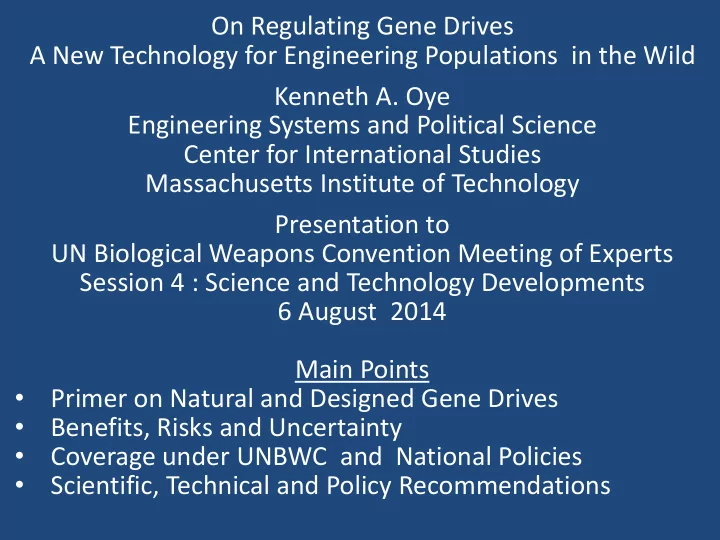

On Regulating Gene Drives A New Technology for Engineering Populations in the Wild Kenneth A. Oye Engineering Systems and Political Science Center for International Studies Massachusetts Institute of Technology Presentation to UN Biological Weapons Convention Meeting of Experts Session 4 : Science and Technology Developments 6 August 2014 Main Points • Primer on Natural and Designed Gene Drives • Benefits, Risks and Uncertainty • Coverage under UNBWC and National Policies • Scientific, Technical and Policy Recommendations
MENDELIAN AND GENE DRIVE INHERITANCE OF ALTERED GENE
MENDELIAN AND GENE DRIVE INHERITANCE OF ALTERED GENE
MENDELIAN AND GENE DRIVE INHERITANCE OF ALTERED GENE
MENDELIAN AND GENE DRIVE INHERITANCE OF ALTERED GENE
HOW GENE DRIVES BIAS INHERITANCE A Altered genes (blue) and wild type (grey) ~ 50 % odds B Altered gene with gene drive and wild type ~ 100 % odds Gene drives cut homologous chromosomes lacking alteration and cause cell to copy altered gene and the gene drive ------ Inheritance biasing “selfish” genetic elements evolve 2003 Burt proposes gene drive design to alter wild population 2012 Charpentier/Doudna/Anderson/Church/Zhang Cas9/CRISPR 2014 Esvelt/Church propose Cas9/CRISPR to create gene drives
TIME LINE ON NATURAL AND ENGINEERED GENE DRIVES ------ Evolution of inheritance biasing “selfish” genetic elements 2003 Burt proposes designed drives to alter wild populations 2012 Charpentier/Doudna/Anderson/Church/Zhang Cas9/CRISPR 2014 Esvelt/Church propose Cas9/CRISPR to engineer gene drives • alter mosquitos to eliminate malaria and dengue • suppress invasive species such as Asian carp, rats • reduce herbicide resistance • create immunization drives to limit propagation • create reversal drives – a partial undo button `
Developers of gene drives accept responsibility to assess and address risks before development and field testing . . . But how? 8
2012-2014 MIT / WILSON CENTER SYNTHETIC BIOLOGY WORKSHOPS Technologists, Environmental Biologists, Firms, NGOs, Regulators 9
10
EFFECTS OF GENE DRIVES POTENTIAL APPLICATION TO . . . Sexually reproducing animals and plants Short reproduction cycles LITTLE OR NO APPLICATION TO . . . Not sexually reproducing – bacteria, viruses Long reproduction cycles - humans, elephants, blue whales Plants from seed produced on controlled seed farms Animals with artificial insemination
SECURITY ISSUES Gain-of-function enabling ability to host diseases Suppression of crops and livestock in traditional agriculture Suppression of pollinators and other keystone species Immunization drives may protect self and allies from effects Reversal drives may be withheld for economic or political gain Security implications uncertain - note ingenuity and creativity ENVIRONMENTAL ISSUES Mutation of gene drives inevitable, will alter effects Lateral gene transfer may reduce discrimination Immunization and reversal may not be effective Diseases borne by vectors will evolve Environmental effects will vary by species and alteration
UN BIOLOGICAL WEAPONS CONVENTION Article 1 “general purpose criterion” bans development, production, or stockpiling of agents that have no justification for prophylactic, protective, and other peaceful purposes. But national measures and Australia Group Guidelines rely on lists of organisms and toxins >> Broad coverage in principle, narrow coverage in practice.
U.S. GOVERNMENT DURC POLICY Section 4 defines DURC as “…. life sciences research that can be reasonably anticipated, based on current knowledge, to provide knowledge, information, products, or technologies that could be directly misapplied to pose a significant threat with broad potential consequences to public health and safety, agricultural crops and other plants, animals, the environment, material, or national security.” Section 6 defines narrow scope of required oversight, focus on experiments of concern on listed pathogens and toxins. >> Broad coverage in principle, narrow coverage in practice
2009 FDA GUIDANCE Regulation of Genetically Engineered Animals Containing Heritable rDNA Constructs An rDNA construct in a genetically engineered animal and is intended to affect animal structure or function meets the definition of an animal drug . . . Developers must demonstrate that the construct and new products expressed from the construct are safe for the animal >> Fit with suppression of Asian carp, zebra mussels or mice?
RECOMMENDATIONS ON USING LEAD TIME Science nerds: Assess environmental and security effects, flag sources of uncertainty, direct research at uncertainty • Effect of genetic instability of drives on environment • Effect of lateral gene flow on diffusion of alterations • Improve test methods - mesocosms and microcosms Technology geeks: Modify organisms and uses to minimize risks by designing, testing and incorporating safety features • Develop and test immunization drives • Develop and test reversal drives • Develop and test precision over generations Policy wonks: Identify and address gaps in policy, fund research, foster informed public debate . . . . • Functional approach -- not just lists of pathogens • Red teaming / white hat hacking to flag misuses • Public debate over benefit/risk in advance of release
ACKNOWLEDGEMENTS MIT SynBio Policy Group: (R) Robert Reardon, Ralph Turlington, Allen Lin, Scott Mohr, Jeanne Guillemin, Kirk Bansak. (F) Kenneth Oye, Shlomiya Bar-Yam, Sarah Jane Vaughan. (N) Evan Appleton, Kelly Drinkwater, Julie McNamara, Gautam Mukunda, Ala’a A Siam Sponsors S Von Boden NSF Theresa Good NSF Keith Roper NSF Parag Chitnis NSF Mark Segal EPA Partners David Rejeski Woodrow Wilson Center Todd Kuiken Woodrow Wilson Center Piers Millett Woodrow Wilson Center Randy Rettberg iGEM Kevin Esvelt Harvard University George Church Harvard University Peter Carr MIT Lincoln Laboratories James Collins Arizona State University Dan Ducat Michigan State University Patrick Boyle Ginko Bioworks Toby Richardson SGI-DNA 17 17 Kirsten Jacobsen Public Health Canada
Recommend
More recommend